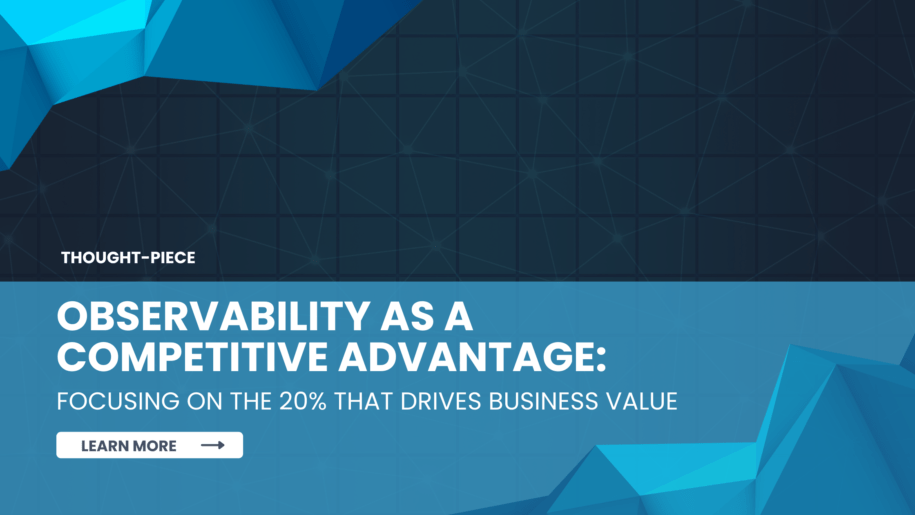Look, we’ve all been there. Your monitoring dashboard lights up like a Christmas tree at 3 AM, drowning you in alerts while you desperately try to figure out which ones actually matter. Meanwhile, your CEO is asking why the new feature rollout is affecting conversion rates, and you’re swimming in data but can’t find the answer.
Here’s the thing: most organizations are doing observability wrong. We’re collecting everything because we can, not because we should. It’s time to flip the script.
The 80/20 Rule of Observability
After working with dozens of engineering teams, I’ve noticed a pattern: roughly 20% of your observability efforts drive 80% of the business value. The rest? It’s mostly noise that’s costing you money and attention.
What’s in that critical 20%? It’s not what most teams focus on.
The Metrics That Actually Matter
- Customer Journey Indicators
- Conversion funnel performance
- User session quality metrics
- Critical path latency (not just overall service latency)
- Revenue Impact Metrics
- Transaction success rates by business segment
- API errors that directly affect paying customers
- Feature adoption rates for premium features
- Engineering Velocity Signals
- Deploy-to-production confidence metrics
- Time to recover from incidents
- Technical debt indicators that affect delivery speed
Stop Collecting Data Just Because You Can
Too many teams proudly showcase their ability to collect millions of metrics. But here’s the uncomfortable truth: most of that data will never help you make a business decision or solve a critical problem.
Instead, start with these questions:
- Does this metric help us understand user experience?
- Can we tie this data point to revenue impact?
- Will this alert help us prevent business-critical issues?
- Could we make a concrete decision based on this information?
If the answer is no, you probably don’t need it.
The Real Competitive Advantage
Your competitors are likely drowning in the same observability ocean. Your advantage comes from seeing clearly while they’re still treading water. Here’s how to get there:
1. Align with Business Outcomes
Don’t just monitor systems – monitor the business. Work with product managers and business analysts to identify the metrics that directly tie to company success. If you can’t explain how a metric affects the bottom line, reconsider its importance.
2. Embrace Context Over Volume
Raw data isn’t insight. Build observability workflows that connect technical signals to business context. Your team should immediately understand the potential business impact when an alert fires.
3. Automate Intelligently
Automation isn’t about creating more alerts – it’s about reducing noise. Build systems that correlate issues and suppress redundant notifications. Your team’s attention is a finite resource; protect it fiercely.
Getting Started: Your First 30 Days
- Week 1: Audit your current observability stack
- List all metrics, traces, and logs
- Tag each with its business impact (direct, indirect, none)
- Identify metrics that haven’t been used in decisions in the last quarter
- Week 2-3: Define your critical paths
- Map your user journeys that directly drive revenue
- Identify technical components supporting these journeys
- Build comprehensive observability around these components
- Week 4: Clean house
- Remove metrics with no clear business value
- Consolidate redundant data sources
- Create clear ownership for remaining metrics
The Bottom Line
Your observability strategy should be a business enabler, not a technical checkbox. Focus on the metrics that matter, ruthlessly eliminate noise, and build systems that help you make better decisions faster.
Remember: The goal isn’t to see everything – it’s to see what matters.
Practical Implementation
While building this focused observability approach might seem daunting, you don’t have to reinvent the wheel. In our recent evaluations, we’ve been particularly impressed with tools that embrace this 80/20 philosophy. FusionReactor stands out as a solution that gets it right – it provides deep insights into the metrics that actually matter for business success without drowning you in unnecessary data.
What caught our attention was how it aligns with the principles we’ve discussed:
- Focuses on business-critical paths out of the box
- Provides clear context for every alert
- Offers enterprise-grade observability features at a fraction of the cost of traditional platforms
Whether you choose FusionReactor or another observability solution, the key is finding a platform that helps you implement these principles without breaking the bank or overwhelming your team.
The best observability strategy isn’t the one with the most data points – it’s the one that helps you ship better products, faster, with confidence.










